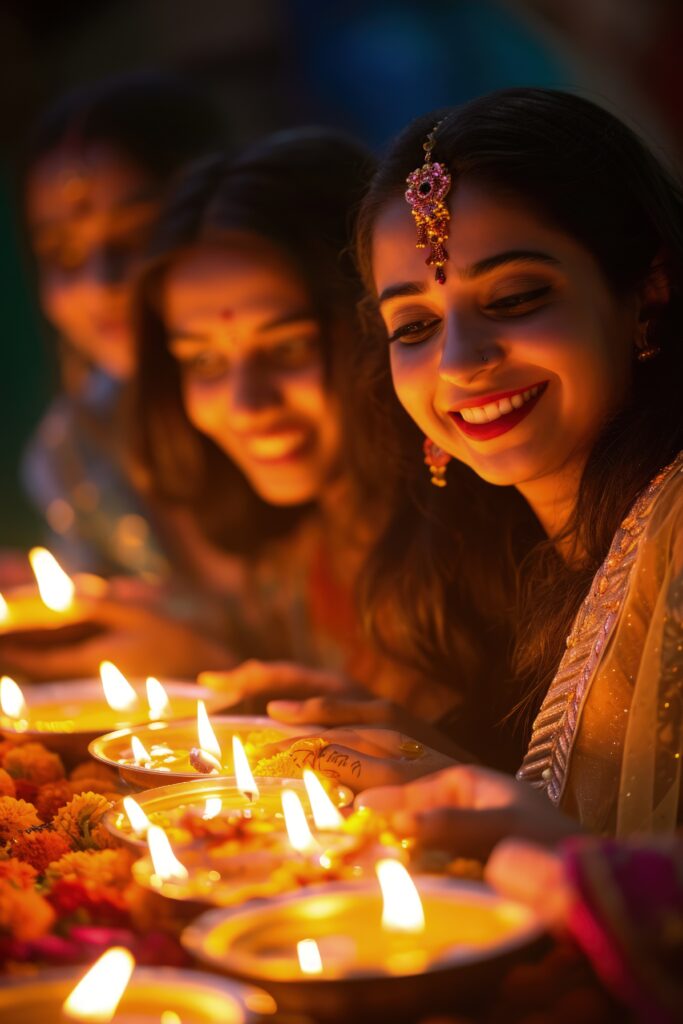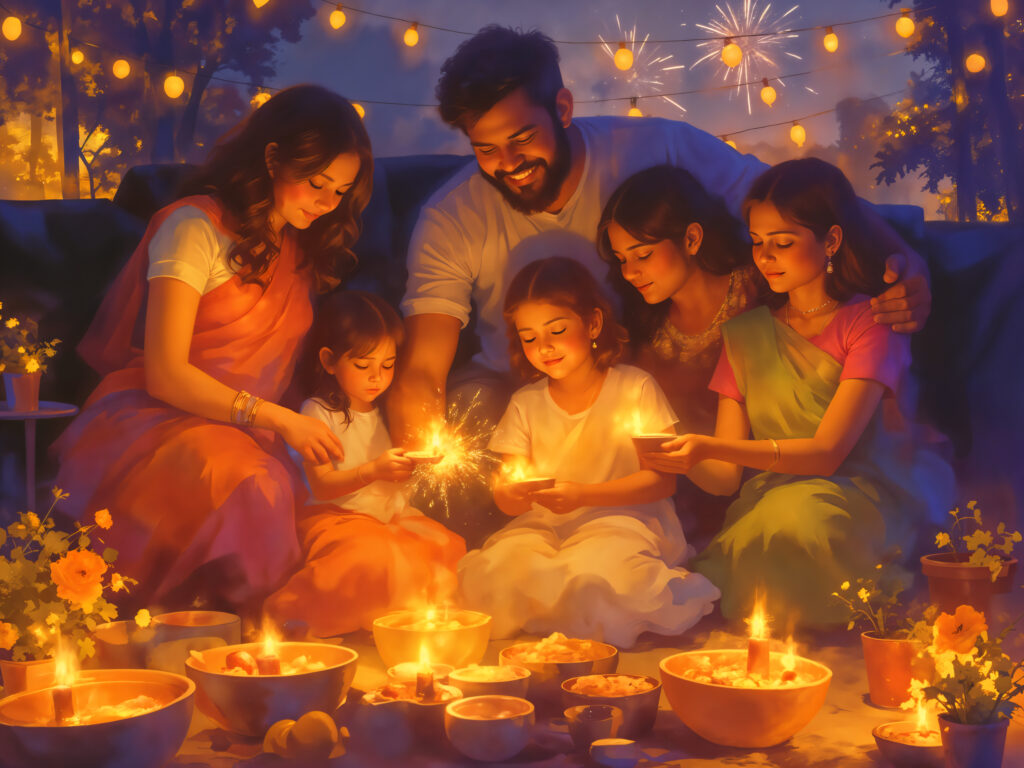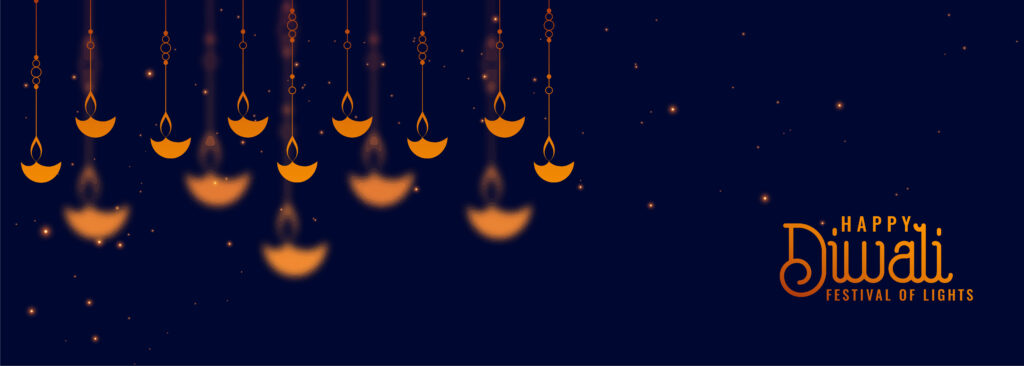Diwali is a beautiful festival of lights, gifts, and precious moments with people who matter the most. It is majorly a celebration of Shri Ram, Mata Sita, and Shri Lakshman’s return to Ayodhya after victory over Raavan and his kingdom along with several regional and religious variations. In this blog today, we will explore crucial dates for Diwali 2025, different traditions, historical significance, process to celebrate, and much more.
Let’s commence with the schedule for Diwali 2025.
Diwali Schedule 2025
| Day and Date | Puja Muhurat | Tithi | Festival |
| October 18, Saturday | Trayodashi Tithi begins at 12:18 PM on Oct 18Trayodashi Tithi ends at 1:51 PM on Oct 19 | Trayodashi Tithi | Dhanteras |
| October 18, Saturday | Trayodashi Tithi begins at 12:18 PM on Oct 18Trayodashi Tithi ends at 1:51 PM on Oct 19 | Trayodashi Tithi | Yama Deepam |
| October 20, Monday | Chaturdashi Tithi begins at 1:51 PM on Oct 19Chaturdashi Tithi ends at 3:44 PM on Oct 20 | Chaturdashi Tithi | Choti Diwali |
| October 21, Tuesday | Amavasya Tithi begins at 3:44 PM on Oct 20Amavasya Tithi ends at 5:54 PM on Oct 21 | Amavasya Titho | Diwali/Laxmi Puja |
| October 22, Wednesday | Pratipada Tithi begins at 5:54 PM on Oct 21Pratipada Tithi ends at 8:16 PM on Oct 22 | Pratipada Tithi | Govardhan Puja |
| October 23, Thursday | Dwitiya Tithi begins at 8:16 PM on Oct 22Dwitiya Tithi ends at 10:46 PM on Oct 23 | Dwitiya Tithi | Bhai Dooj |
Now that we have a schedule of Diwali 2025, let’s go ahead with What is Diwali? Significance and History behind this festival of lights, and best ways to celebrate Diwali this year with green crackers, friends and family, and spread the universal message of love for humankind.
What is Diwali?
Diwali or Deepawali is the Festival of Lights. It is one of the biggest and most widely celebrated festivals across India and among Indian communities worldwide. The name comes from the Sanskrit dīpāvali, meaning “row of lights.”
At its heart Diwali celebrates the triumph of light over darkness, knowledge over ignorance, and good over evil. Though commonly observed over five days, the stories, rituals, and emphasis vary widely by region, religion, and community.

Regional Histories Around Diwali: Many Origins, One Spirit
Diwali’s multiplicity of meanings is one reason it endures. Different regions link Diwali to different legends and historical events, all conveying similar moral ideas.
North India: Return of Shri Rama to Ayodhya
The dominant narrative in much of northern India is from the Ramayana: Lord Rama returned to Ayodhya after 14 years of exile and after defeating Ravana. Citizens of Ayodhya welcomed him by lighting lamps; Diwali commemorates this homecoming and the victory of dharma (righteousness).
South India: Victory over Narakasura/Naraka Chaturdashi
In many southern states (Tamil Nadu, Karnataka, Andhra Pradesh, Telangana) the festival is linked to Krishna’s slaying of the demon Narakasura (Naraka Chaturdashi), celebrated with ritual oil baths, early-morning festivities, and sweets. This variation emphasizes personal purification and the defeat of inner and outer evil.
East India (West Bengal, Odisha, Assam): Kali Puja and Shakti traditions
In Bengal and parts of eastern India, Diwali night is often associated with Kali Puja. Historically this region also has Lakshmi worship, but Kali Puja became particularly prominent from the 19th–20th centuries and is now central to local observances.
Check out top 10 Kali Puja pandals in Kolkata 2024 that you can visit in upcoming Kali Puja 2025.
Punjab: Bandi Chhor Divas (Sikh observance)
For Sikhs, the day coinciding with Diwali marks Bandi Chhor Divas, when Guru Hargobind Ji was released from imprisonment and returned to Amritsar; the Golden Temple is illuminated and community celebrations follow.
Jainism and Buddhism (Newar Buddhists)
Jains observe Diwali as the day Lord Mahavira attained moksha (final liberation), while Newar Buddhists have their own localised customs. These differences highlight how Diwali’s theme of inner light and liberation resonates across faiths.
All these stories share a core message of renewal, the removal of darkness (fear, ignorance), and the welcoming of prosperity and harmony.
What are the Best Ways to Celebrate Diwali: Meaningful, Safe, and Sustainable
Rituals for Diwali are familiar that include lights, rangoli, sweets, prayers, gifts and fireworks. However, we are suggesting here some modern and sustainable ways to celebrate Deepawali that keep tradition while reducing environmental harm and waste.
Clean and Decorate with Intention
Deep-cleaning the home and creating a rangoli or diya display is a symbolic way of inviting prosperity. Use eco-friendly rangoli colours and natural materials (rice powder, flower petals).
Light Responsibly
Use oil diyas or LED lamps to preserve the traditional glow with less smoke. Arrange candles and diyas safely away from flammable materials.
Offer Simple Puja and Prayers
Perform Lakshmi puja (or regional equivalent) with family: a short aarti, flowers, incense, and an offering of prasadam/sweets. If you follow a different tradition (Kali Puja, Bandi Chhor observances), follow your family rites.
Share Sweets and Meals
Homemade sweets or local mithai help keep community ties strong. Consider sharing extra portions with neighbors or a local charity.
Gifts and New Purchases with Meaning
Prioritise quality and need. Buy something small and meaningful (books, useful home goods, gold/silver on Dhanteras) that is traditional and adds value.
Be Considerate About Fireworks
If you choose to burst crackers, do so in moderation, follow local laws, and prioritise safety: keep water handy, avoid crowds, and avoid noisy or polluting crackers where banned. Consider quieter alternatives and green crackers.
Celebrate Inclusively
Diwali is a great opportunity for cultural exchange. Invite neighbors of other faiths, and share the story behind your family practices.
Significance of Each Day of Diwali 2025
Dhanteras (Day 1): Wealth & health
Dhanteras (Dhantrayodashi) inaugurates Diwali. Traditionally people clean homes, light lamps at the entrance, and purchase precious metals, utensils or appliances as auspicious purchases.
The day honours Lakshmi, Kubera (treasurer of the gods), and Lord Dhanvantari (health/medicine in some traditions). It’s considered a good day for new financial beginnings.
Naraka Chaturdashi / Choti Diwali (Day 2): Victory over evil & purification
This day remembers Krishna’s victory over Narakasura in much of South India; rituals often include an early morning oil bath and small pujas. In other regions it’s a quieter day of preparations: more cleaning, lighting, and family gatherings. Some places call it Choti (small) Diwali.
Lakshmi Puja / Diwali (Amavasya night, Day 3): Main festival night; wealth & light
The third day (the darkest night of the lunar month) is the core Diwali night: homes are illuminated with diyas and lights; families perform Lakshmi Puja to invite prosperity; there are feasts, exchanges of sweets and gifts, and fireworks (where permitted). In Bengal this night may be observed as Kali Puja instead.

Govardhan Puja / Annakut (Day 4): Gratitude to nature & Krishna’s protection
Celebrated especially in Mathura–Vrindavan and among followers of Krishna, Govardhan Puja commemorates Lord Krishna lifting Govardhan Hill to shelter villagers from Indra’s storm.
Devotees prepare large food offerings (Annakut / “mountain of food”) and express gratitude to nature. It’s also considered the start of some regional new years and business accounting cycles.
Bhai Dooj / Bhau-beej (Day 5): Sibling bonds
The final day honours the brother–sister relationship. Sisters perform a tilak ritual and pray for brothers’ well-being; brothers give gifts in return. It’s a warm family day bringing the five-day festival to a close.
Conclusion
Diwali’s strength is its plurality: a single festival embraces many histories, rituals, and local flavours while keeping a shared message — light over darkness, renewal, and community. Whether you mark Diwali by lighting diyas, preparing sweets with family, performing region-specific pujas, or quietly reflecting on what you’re grateful for, the festival invites warmth, generosity, and fresh beginnings.
Frequently Asked Questions for Diwali 2025
When is Diwali in 2025?
In 2025 the Diwali period falls in October — Dhanteras on Oct 18 and Lakshmi Puja/Diwali (Amavasya night) on Oct 21 (dates vary by local calendars).
Why do people light lamps?
Lamps (diyas) symbolise the victory of light over darkness and knowledge over ignorance; they are offerings welcoming prosperity and dispelling fear.
Is Diwali celebrated the same everywhere in India?
No, while the themes are similar, northern, southern, eastern, and western India each have distinct histories and rituals (Shri Ram’s return, Naraka’s defeat, Devi Kali Puja, Bandi Chhor Diwas, etc).
What should I avoid during Diwali?
Avoid unsafe fireworks, wasteful consumption, and ignoring local laws about noise or pollution. You should also be cautious with open flames and ensure elderly or pets are kept safe during celebrations.
What is a meaningful gift for Diwali?
Practical, well-made items (kitchenware, books, clothing), homemade sweets, or a thoughtful donation in someone’s name. On Dhanteras, small purchases of metal (silver/gold) are traditionally auspicious.

1 thought on “Diwali 2025: Everything You Need to Know”